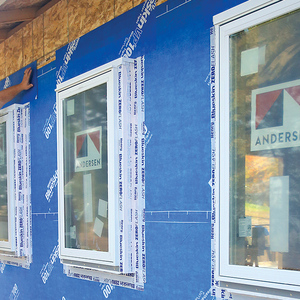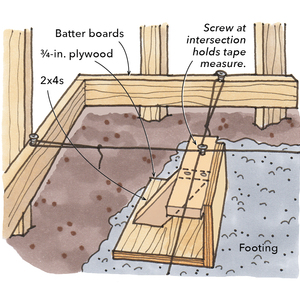Being “real” energy alert now, I am wondering if I should consider adding rigid foam under the roof sheating between rafters. My attic is now at around R50. The roof is thick butt cedar shingles. Has anyone done such a thing? Does it work? What effect will it have on the wood shingles? Thanks.
Discussion Forum
Discussion Forum
Up Next
Video Shorts
Featured Story

A rear addition provides a small-scale example of how to frame efficiently.
Featured Video
How to Install Exterior Window TrimHighlights
"I have learned so much thanks to the searchable articles on the FHB website. I can confidently say that I expect to be a life-long subscriber." - M.K.
Fine Homebuilding Magazine
- Home Group
- Antique Trader
- Arts & Crafts Homes
- Bank Note Reporter
- Cabin Life
- Cuisine at Home
- Fine Gardening
- Fine Woodworking
- Green Building Advisor
- Garden Gate
- Horticulture
- Keep Craft Alive
- Log Home Living
- Military Trader/Vehicles
- Numismatic News
- Numismaster
- Old Cars Weekly
- Old House Journal
- Period Homes
- Popular Woodworking
- Script
- ShopNotes
- Sports Collectors Digest
- Threads
- Timber Home Living
- Traditional Building
- Woodsmith
- World Coin News
- Writer's Digest


















Replies
Not a pro at this, but I dont see any benefit from insulating the rafters. The insulation on the attic floor makes it an unconditioned space and because of that you're not gonna accomplish much by insulating the rafters.
You have R-50 on the floor I think you may be well covered.
Thanks for the note. I've read so much about using foam between rafters on super energy efficient homes that I'm thinking I'm missing something.
jr40
Let me see if I can make things clear for you.
Most attics are uncondtioned spaces.. they are insulated from heat loss by the insulation on the floor. At the edge of the attic under the eves usually are vent holes designed to help prevent ice dams and prolong the life of your shingles..
If however your attic is completely sealed up added insulation under your shingles won't hurt. It's not the most effective but it won't help much. Sort of like going from R50 to R75 not really cost effective..
Look up Hot roof versis cold roof if you'd like it explained more completely. Or just ask here..
Oh, no! Not hot-roof/cold-roof AGAIN...! I haven't got my Nomex suit back from the dry cleaners yet!
LOL....
http://forums.taunton.com/tp-breaktime/messages?msg=106537.1
That thread has a fairly comprehensive explanation of the physics of roof ventilating, plus some scary photos of what happens when you don't. (Plus some nasty flamethrowing from another source, LOL, but whaddya expect....)
Dinosaur
How now, Mighty Sauron, that thou art not broughtlow by this? For thine evil pales before that whichfoolish men call Justice....
so did you finally realize you were wrong?;)BTW, I have been looking right thru your flameup signature file since it had been here for so long, but recently started looking at it again. Seems like I see a face in the explosion befor ethe cloud goes up. Is that the diabolical face of a former spouse I see?
Welcome to the Taunton University of Knowledge FHB Campus at Breaktime. where ... Excellence is its own reward!
No, that's a pic of Sauron in a bad mood. X isn't that pleasant looking.
Dinosaur
How now, Mighty Sauron, that thou art not broughtlow by this? For thine evil pales before that whichfoolish men call Justice....
Thanks, that was a great help. I feel O.K with my current insulation set.
Here is something else to think about... assuming you have forced air, I wonder how leaky your duct system is?
I have tried to tape as many connections as I could. In the attic, my ductwork is insulated flexible 6" tubing. I have tried to reduce the number of bends and curls as possible and go for the straightest lines to the vent opening into the ceilings. I wrapped the rectangular 8 x 10 ducts in the crawlspace with 1"insulation fiberglass....That reminds me of another question. In a new addition, 20' x 16', over a crawl space, the contractor did not place any foundation vents. The foundation is block wall, not poured. Shouldn't I be thinking about venting that space somehow?
With the duct leakage, the best way to address that is with duct mastic. It comes in a 1 gallon can and you paint it on. It's like a paste.
Regarding the addition crawl space, it either needs to have the ceiling (house floor) insulated and have foundation vents or it needs to have the block walls insulated (no vents) and some conditioned air from the HVAC being pumped into there. In either case the CS dirt floor needs to be 100% covered with a vapor barrier. In the case of the non-vented crawl the vapor barrier becomes even more important so the VB seams must be sealed and it needs to be glued to the CS walls. With this "sealed crawl space" the area must be perfectly dry. 6 mil black polyethylene is the default VB but there are other, better products out there which are more expensive. If the CS floor happens to be covered with concrete, it still needs the plastic - weather above or below the concrete.
Proper treatment of the CS is not so much an energy saving thing as it is just a "healthy house" thing. Moisture can build up down there and cause the floor system lumber to rot and mold and fungus can grow down there.
To learn more about "sealed crawl spaces", also known as "conditioned crawl spaces" go to the Building Science Corp web site. They have great info on energy savings too. Don't fall to hard for their hard sell though. Although they have some great ideas their way is not the only way.
Thanks for all the excellent information. I have plastic vapor barrier on the dirt and the walls are covered with glued on 1" foam board. I cut through the original house poured wall into the crawl to add HVAC ducts. The opening is about 4" wider than the ductwork (8 X 10). I am going to get busy with your information in mind. Thanks again. You are very helpful.
I'd agree with MSA1. Put the effort into other things, such as making sure all penetrations of the ceiling are sealed, removing window trim and foaming around windows (low-expansion foam please!), etc.
I used fiberglass insulation around the windows when I built the house. Would foam work better or am I good with the fiberglass tucked in the spaces? I have foamed around the penetrations of electric, and around the furnuce flue, fireplace, etc. Hope that works this winter as well.
You're probably good, if it's tucked reasonably tight.
It is an ironic habit of human beings to run faster when we have lost our way. --Rollo May
It would help if you'd fill in your profile so we'd know where you are located. The answers to a lot of questions like this depend on the climate.
Dinosaur
How now, Mighty Sauron, that thou art not brought
low by this? For thine evil pales before that which
foolish men call Justice....
Thanks Dino, this is Springfield, Il where the winters get pretty cold but not so bad as 200 mi. north of here.